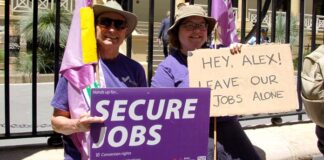The call for greater efforts to boost productivity has become a constant refrain from business and government. Reserve Bank Governor Glenn Stevens added his voice to the chorus during a parliamentary economics committee at the end of August. The Australian newspaper in particular has harped on about Australia’s supposed decline in productivity growth.
“Multi-factor productivity”, the most sophisticated measurement of it, has grown at 1.1 per cent on average for the last 40 years. But from 1993 to 1999 it jumped by 2.3 per cent a year. Since then it has slowed and from 2003 until 2008 actually went backwards by 0.3 per cent a year.
Productivity is a measure of the amount of goods and services produced by the workforce per hour worked. This is key to business competitiveness and profit-making.
CEOs are concerned to get the maximum output from their investment in tools, machines, and labour. They want to maximize the amount produced by workers in each waged hour in order to undercut competitors and reap greater profits.
One way productivity can be increased is by bosses investing in new machines that allow less workers to produce the same or greater amount of goods or services (called “capital deepening”).
The other method increases the amount of value workers can produce each hour by training them more, or by simply forcing them to work harder.
Keating-era ‘reforms’
The current “productivity debate” is a campaign to find ways to return to the “productivity miracle” associated with Paul Keating’s deregulation and industrial relations reforms in the early 1990s. Reserve Bank Governor Stevens said in August: “I don’t think there’s any doubt that the period of maximum focus on productivity-enhancing reforms was in the [Keating] period.”
But Keynesian economist John Quiggin argues that the “productivity miracle” was almost entirely the result of “increases in the pace and intensity of work”. Vicious economic restructuring by the Hawke and Keating governments allowed bosses to squeeze more from their employees.
First came the acceptance of a “no-strike” pledge through the Accord between the ACTU, the Hawke government and business, signed in 1983. This undermined the strength of union organisation, weakening the capacity of workers to resist restructuring and work intensification.
Then in the early 1990s came the shift to enterprise bargaining, where union leaders agreed to deliver productivity increases in exchange for wage rises.
One aspect of this was the growth in unpaid overtime. This delivers extra productivity through increasing the amount of work done, but is hidden in statistics because it is unpaid work. An ACTU survey released last month of 42,000 workers showed that 61 per cent of respondents work more hours than they are paid for and 41 per cent receive no compensation for extra hours worked.
Business wants more of this. Glenn Stevens speaks for many at the top with concerns that outside the mining industry lies a declining economy. Productivity increases are seen as the solution.
Anti-worker laws
But it is not investment in new technologies that the CEOs are talking about. Echoing the investment strike that continues to plague the global economy, in Australia investment is flowing only to where the profits are guaranteed—the mining industry. Calls to increase productivity are really calls for us to work harder.
Former Australian Building and Construction Commission boss John Lloyd is campaigning against collective bargaining. Lloyd represents a growing section of the business community that want to see Abbott’s Liberals fight for changes to the Fair Work Act, including the reintroduction of Australian Workplace Agreements (individual contracts).
While trying to dodge the politically poisonous issue of WorkChoices, they argue that the key to productivity increases is “flexibility” in the workplace, or the unconstrained power of employers. The retail industry has joined these calls with their campaign against minimum wages and penalty rates.
The Labor government, on the other hand, stresses that productivity can be increased through investment in infrastructure and training. The National Broadband Network and National Training schemes are part of her answer.
Business supports infrastructure investment—but it would rather have workplace “flexibility” as well. Keating’s neo-liberal shock treatment continues to inspire the Gillard government too. Treasurer Wayne Swan has made it plain that his government wants to increase business profitability:
“Putting in place the big reforms wasn’t easy in the ‘80s and ‘90s… But it’s never been the Labor way to shy away from the tough reforms we need for future prosperity, and it won’t be under the Gillard government.”
But the prosperity Keating presided over was that of the bosses. Talk about a “productivity slump” are attempts to find new ways to make workers deliver increased profits.
Jean Parker





